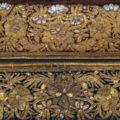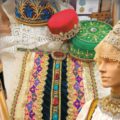The sparkle and shine of goldwork
The Tyumen region is one of the most interesting regions of Russia for its rich history, as well as for its modernity. The Tyumen region is home to over 140 nationalities, united by cultural, spiritual and natural heritage living in peace and unity. Traditional crafts of the region have a history that goes back centuries. Tyumen shag rugs and Tobolsk bone carving, painted pottery and carved wooden platbands, embroidery and hand weaving were displayed with great success at all the largest Russian and international exhibitions in the 19th through early 20th centuries.
The goldwork embroidery was the handicraft widespread among the urban and peasant population and in the goldwork workshops of monasteries and churches, in particular in the Tobolsk Ioanno-Vvedenskiy Convent. The Swedish researcher Johan Falk, a member of the Russian Imperial Academy of Sciences and Arts, wrote about Siberian women in the middle of the 18th century: “They make canvas and peasant cloth, knit stockings and gloves, weave braids, lace and fringe, embroider kokoshniks in gold and silver… ”.
Goldwork has always been very valuable. Items with precious embroidery were carefully stored and passed on from generation to generation. Its tradition came to Russia in the 10th century from Byzantium after the adoption of Christianity. Embroidered pieces played an important role in the decoration of churches and cathedrals because of the spiritual meaning of gold and silver. It is no coincidence that, due to the abundance of “splendor and radiance of goldwork embroidery”, contemporaries often called the Orthodox Church “magnificent, oriental, Byzantine.” Goldwork items being especially priced, were given as gifts to clergy and rulers of other countries.
The museums in the Tyumen region display unique items made in the goldwork embroidery workshop of the Ioanno-Vvedensky convent in the 18th–20th centuries. These are the robes of the clergy, embroidered with gold and silver threads: miter (headdress), feloni (upper vestment), oversleeves and belts, as well as sacred objects of church decoration: icons with their covers or rizas, cloaks, banners and shrouds. For many years the Convent used to be the center of the embroidery art in Western Siberia. The year 1904 was significant in the life of the Ioanno-Vvedenskaya convent, when its goldwork was displayed at the 1st All-Russian Exhibition of Monastic Works and Church Utensils. The exhibition was organized at the Tauride Palace in St. Petersburg under the auspices of the Imperial House.
Skullcaps, sarauts, izu, kokoshniki…
Tyumen has always been a major trade and handicraft center that connected the markets of Europe and the East. So, in the 17th century, came Tatar-Bukhara settlement across the Tura River, opposite the city. It is well known that in addition to trade, Bukharians and Siberian Tatars were engaged in crafts including goldwork embroidery. The goldwork was mainly used for the national men’s and women’s clothes such as skullcap, sarautsy (headband), izu (shirt front part), bridal head veil, jewelry, boots and shoes, velvet kalfaki (headdress) with their characteristic patterns of a flower bouquet, a golden feather and “birds of happiness”.
Since the second half of the 19th century, goldwork has become a folk craft. Peasant women of the Tyumen District sold their works at marketplaces and fairs. Craftswomen skillfully embroidered sundresses, belts, hats for sale and as commissions. In Russia, a headdress has always been the most significant and elegant item of a woman’s costume. Wedding kokoshniks, headbands and kerchiefs were embroidered with precious threads, river pearls and beads sometimes all over. The Siberian craftswomen used expensive dense fabrics for embroidery: taffeta, satin, brocade and velvet. Embroidered items were decorated with sequins, precious stones, jewelry plaques and tinsel braid. Goldwork thread had different weaves and shapes; it could be round in cross-section or flat, as well as faceted or twisted. A simple gold thread was too fragile for embroidery. Therefore, it was laid upon the fabric and attached to it with silk thread. Silk thread was selected to match the color of gold to create a one-color pattern, or a contrasting shade was used to get a colorful pattern. Over time, the range of products, their purpose and place, the patterns and compositions, the sizes and proportions and the artistic approach for goldwork embroidery was changing, but its special techniques remained unchanged.
Revived traditions of Siberian craftsmanship
Unique pieces of goldwork kept for many decades, and sometimes even centuries in the Tyumen region museums, helped revive the tradition of the Siberian craft and its stylistic features. Thanks to Tyumen researchers and museum workers, interest in goldwork embroidery is being revived.
The art of Siberian goldwork within the framework of the Culture of Russia. Creative People National Program was supported by local authorities and the Department of Culture. As a result, the Siberian Gold Embroiderers workshop was opened in Tyumen and was designated the UNESCO Club status by the Commission for UNESCO of the Russian Federation. In 2021, the Historical Reconstruction Club was created at the Institute of Architecture and Design of the Tyumen Industrial University. The club conducts interactive excursions along with master classes and organizes visits to the Painting with a Needle: Tradition And Modernity exhibition. The club trains craftswomen in goldwork techniques for modern accessories, souvenirs and traditional costumes from different eras.
Elena Suleimanova,
Head of the Siberian Gold Embroiderers UNESCO Club
The article uses photographs of museum funds of KATU TO TMPO and Embayev Village Museum, as well as photographs of collections and activities of UNESCO Club “Siberian Gold Seamstress”
 On September 24, 2021, Tobolsk hosted a round table discussion called, “The Traditions of Gold Embroidery as a Tourist Destination in the Tyumen Region”. During the talk, experts in the field of cultural heritage preservation recognized gold embroidery as a new tourist brand of the Tyumen region.
On September 24, 2021, Tobolsk hosted a round table discussion called, “The Traditions of Gold Embroidery as a Tourist Destination in the Tyumen Region”. During the talk, experts in the field of cultural heritage preservation recognized gold embroidery as a new tourist brand of the Tyumen region.




